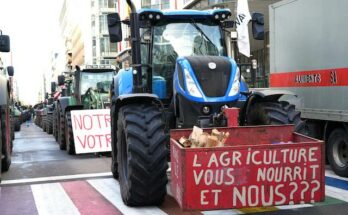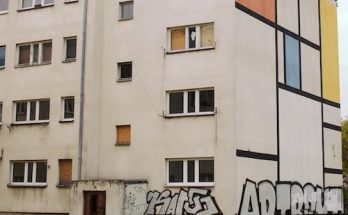Time for a cuppa: but no copper to be seen.
A north Lancashire community has built a hyper-fast broadband network with a shovel and a nice cup of tea. Life is as it used to be and will never be the same. The Mint talks to Broadband for the Rural North co-founder, Monica Lee.
Barn raising was a common and admirable practice of a couple of centuries ago when families in rural communities often had a need for a barn but didn’t have the financial or physical wherewithal to build one. So when (say) a young man and wife needed a barn, all the folk in the village would lend a hand. They would all make a nice day of it too with a bit of a party and the kids would have a carefree play – not a health and safety concern to be seen.
Ultimately there’s a very clear and hard logic in play in barn raising in that the willing workers all knew that the young couple would, in due course, be doing the same for them. Everyone was a winner. Now, while the demand for barns is not what it was in Georgian times, it seems the logic and spirit behind barn raising still has its uses in the unlikely would of broadband provision.
“They made it clear that we just weren’t economically viable and people within rural communities ought to expect bad broadband.”
In this story of a 21st century barn raising barn is, naturally, spelt B4RN and its construction began in Lancashire in 2011 where the pace of life was matched by the internet link. “We live out in the high hills just behind Lancaster and had very, very bad broadband and there was no chance that BT could improve it in any way. They made it clear that we just weren’t economically viable and people within rural communities ought to expect bad broadband,” explains Broadband for the Rural North (B4RN) co-founder, Monica Lee. B4RN is a not for profit, community benefit society behind a fibre optic broadband network, run by dedicated local teams with the support of landowners and volunteers. It offers 1,000Mbps symmetrical broadband to every property in its coverage areas, for £30 a month.
Lee and, now B4RN chief executive, Barry Forde, along with other volunteers, set the venture up with a very local focus on their community in and around Arkholme (population 340) and Quernmore (570). “Our plan was quite small to start with,” says Lee. “Seven parishes, we thought, would be enough to keep us going with the service income. We are luckily right near a major node so that we wouldn’t have had far to dig to access the whole network. So we were thinking, we’ll do this, and we did it as a community run benefit society. I think that was really important because we were very clear from the start that no one wanted to make money out of this. It’s not a money-making operation as such.”
“Lee reveals a sympathy for her commercial adversaries that’s probably unheard of elsewhere in the telecoms sector.
The operation has shareholders who receive a fixed 5% dividend and have a full say in the direction of the company. People can either pay for shareholding or they can, “in effect earn digging shares” by lending a hand to the construction of trenches needed to carry the fibre optic network that B4RN has built and continues to build. This enables farmers and other landowners who allow B4RN to install its network on their land, to receive a shareholding based on the length of cable installed on their property.

“If shareholders get £1,500 worth of shares either through digging or buying, then they get a free connection. They still have to pay service fees, but it encourages people to take part in B4RN, which is essentially what it’s all about,” says Lee.
But Lee emphasises that the venture is for the communities: “Any money it does make goes back to the community, we want that to be absolutely clear. We aren’t out to make lots of money for shareholders; that’s not our aim. Our aim is to provide broadband for rural communities,” she says.
Perhaps ironically, B4RN’s customers are getting a “gold standard” broadband network that is currently not available to most urban internet users. It comprises high data-carrying capacity optical fibre – 1Gb a second upload and download – all the way into the home of the user. In towns and cities what is often called a fibre connection is not entirely fibre. The fibre connection ends at the junction box and from there to the home it is copper cable as in the days when the Post Office ran telecommunications. So unless a house is close to the cabinet it will get a lesser service compared to a full fibre connection like B4RN’s.
And the B4RN fibre is all underground – “future-proofed and sustainable”.
There are, however, some uphill stretches in B4RN’s journey: “One of the early struggles which we still have is that we rely not just on the volunteers to do the work, but also on the landowners to provide wayleaves for the cables going under their ground. That is where farmers could certainly make a fair amount of money, normally, for cables going under their ground,” says Lee, adding: “We’re relying on them to donate the wayleaves, which they have been very, very good about doing. They do benefit too, because as it goes through their land, they get communication ability as well as increasing the value of any properties on their land.”
“We were very clear from the start that no one wanted to make money out of this.”
Lee reveals a sympathy for her commercial adversaries that’s probably unheard of elsewhere in the tech sector. And it’s arguably a summary of the commercial power of the socially focused B4RN arrangement model over a shareholder model. “I do feel sorry for the incumbents,” she declares. “They have to pay for wayleaves, they have to serve the needs of their shareholders and any money that comes in has to then go straight out to shareholders. Whereas B4RN or its equivalents come along and say, ‘Okay, you give us the wayleaves but any money then that comes in goes back to you.’ It goes back to the community. It’s a much nicer model for people to work with, so people get quite enthusiastic about that.”
Getting a project off the ground based on voluntary contributions clearly has to first have a willing, or at least a well-motivated, community. Lee acknowledges the value of the early support provided by her neighbours: “We wouldn’t have got anywhere if we didn’t have a host of volunteers, who got totally enthusiastic, believing, quite rightly, that they’re doing something long-term for their community.”
In the seven years since B4RN was launched it has changed and grown and is now operating outside its original Lancashire home. Lee explains how new hurdles have emerged since the business achieved lift off, highlighting “moving from an entirely volunteer structure to a management structure that maintained the volunteer ethos. We’re still doing it, and some people still find it hard work and others don’t.”
“We wouldn’t have got anywhere if we didn’t have a host of volunteers, who got totally enthusiastic.”
Another problem has arisen from success. “A real challenge we’re facing now is we’re so popular, because we’re just charging £30 a month for a full 1,000 Mb/s service, without different levels of service or charging structure,” Lee explains. She estimates that some 5,000 people will be connected to B4RN by the end of this year. “The B4RN network is now greater than the area within the M25, though with fewer people.”
She goes on: “So as people from one community have seen what their neighbours are getting, then they want to join in. And we’re trying to make it very clear that it’s not us going to them; they are joining us and they need to raise the cash for the fibre and everything. We’ll help them, but it’s not us providing a normal commercial service; it’s people joining in to become part of the whole network.”
The new communities have to find their own volunteers and landowners who are willing to provide access to their land for shares in the operation. They then become sub-communities with the support of B4RN. Lee says that until about a year ago, these sub communities were contiguous to the Lancashire original. Now there are groups setting up in areas quite distant from the northern root including Surrey and Norfolk. This recent growth, Lee says, has been seeded over the past two years by government support for fibre networks that extend into the home.
“The government is trying to work to find ways to let groups set up on their own,” says Lee. “One of the things that it has done is make it easier for groups to use the dark fibre, which is the main trunk routes that BT, Virgin and all the others have got in the ground, which normally people wouldn’t have access to. But now they’re opening that up so that companies … not anybody, but companies like B4RN can go to them and say, ‘I would like to lease some part of your route there.’ Of course once we can do that we don’t have to dig down to Norwich – we can lease the routes and work that way. So now it’s open for all sorts of sub-groups to work together in different ways, using existing structures.”
Lee believes B4RN has revived fading communities by employing people and, more significantly, upping economic activity by providing good broadband. She says the better quality connection has helped increase the numbers of people working from home in some regions. And she says there are growing numbers of people and businesses seeking to rent properties that are connected to the B4RN network. “There is clearly now a desire to move into the B4RN area, which is different from ten years ago when everyone was desperately trying to leave the countryside to go and find jobs elsewhere.”
A particular feature of B4RN in her region of Lancashire has according to Lee, been in drawing together the incumbent agricultural and relative newcomers. “B4RN has affected the communities quite dramatically in places,” says Lee. “This is one of the things that particularly interests me, because I’m a smallholder and at the same time an academic. So I’ve lived with two hats, the rural and the academic.” The rural communities around Lancaster where Lee lives include academics from the university and the “very deeply agricultural” locals. Lee says the two groups typically used to “just slide across each other and never really talk.” B4RN, she says has given the two communities a common purpose to work together “because everyone wants the broadband.” She continues: “The farmers have got the land and the digging equipment, and the ability and time, and the academics have got the money to put in, which quite frankly is also needed.
“Perhaps ironically, B4RN’s customers are getting a “gold standard” broadband network that is currently not available to most urban internet users.”
Most of the volunteers are, Lee says, retired, “sitting at home doing nothing.” When B4RN came along “they came out and they dug, and they helped, and got a new lease of life.” Not all of them were inclined or even up to wielding a shovel. “You don’t have to. People could come along bringing cups of tea and cake. That’s as much use as actually digging half the time.”
So it has, according to Lee become a community activity, digging, helping in other ways and making a day of it – a modern day barn raising. But once the party is over and the fibre is in the ground, does the newly found bonding between the formerly disparate communities return to their old ways?
Lee says there has been some preservation of the social ties that emerged through the B4RN construction period but she is “very concerned about keeping the community spirit going from B4RN.”
She emhasises that B4RN is not unique as a local broadband-building venture. She believes its success to date has been helped by the combination of her background in developing “creative organisations” and the “world class” understanding of network design of Forde. “Certainly when we were starting five years ago, there were a lot of different groups starting, but B4RN is the only one who’s really carried on in this way. I think that’s largely because of the people involved.”
For the future Lee expects the numbers served by B4RN to grow slowly. But her personal focus remains on the prospect of being able to plough some of its income into the communities it serves: “With our current 5,000 customers paying £30 a month, you quite quickly get a lot of money coming in. At present we’re using that on running costs because we are growing so much, but in the longer term there is a real potential to try and do good to the communities. Putting money back into the communities, so even at 5,000 connections, there’s a lot of benefit that can be given.
“And one of the next challenges, will be how to do that in a way that’s fair and fully beneficial.”
It’s tempting to conclude that, even in the world of information technology, the old ways might be best.




